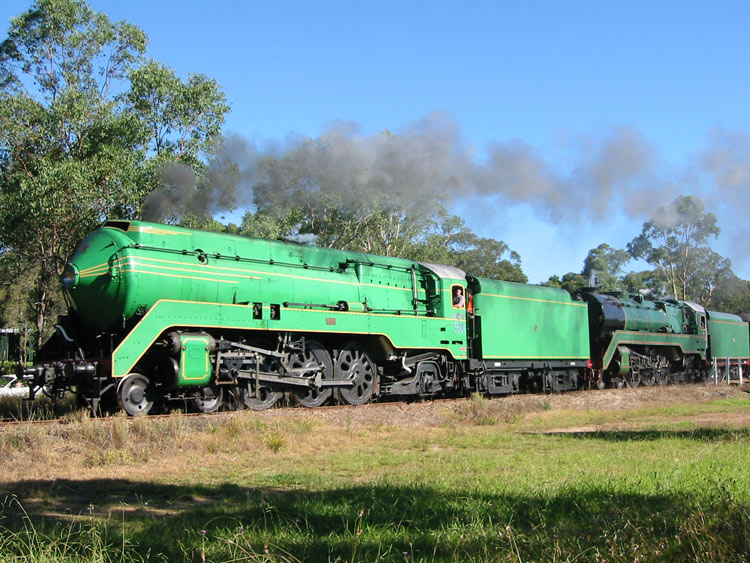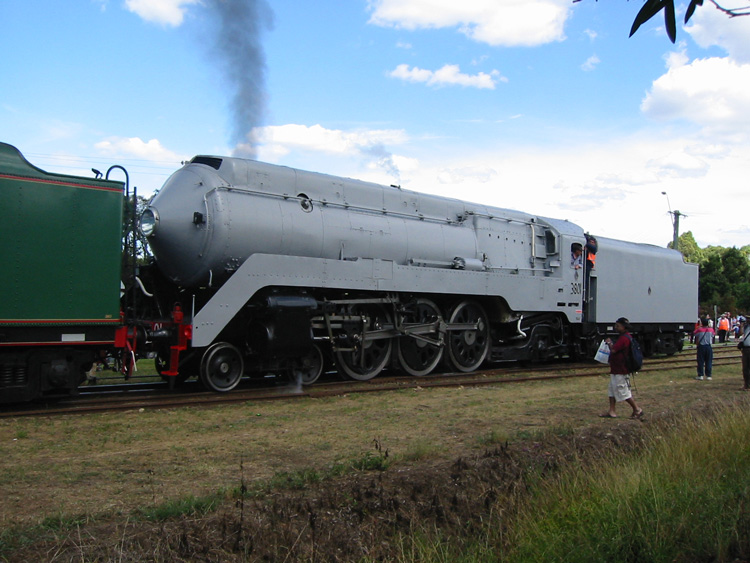|
|
3801 Australia's most famous locomotive |
|

3801 shunting at Thirlmere station during the NSWRTM gala
of 6 March 2005.
|
Builder |
Granville NSW |
|
Build Year |
1943 |
|
Wheel Arrangement |
4-6-2 |
|
No. in class |
30 comprising: - 5 streamlined (3801 – 3805) - 25 semi-streamlined (3806 –
3830) |
|
Many
detailed articles and publications have been written about 3801 and the (C)
38 class locomotives; rather than repeat these sources, the text below is
offered as an overview and some personal reflections on 3801's significance. Design
& Construction 3801 was
built by Sydney company The Clyde Engineering Co. Ltd., Granville in 1943 as
the first of five streamlined (C) 38-class locomotives for the New South Wales
Government Railways’ (NSWGR) top-link express passenger duties. The design
included elements of contemporary American practice, such as a cast-steel
frame with integral cast cylinders, rather than the more-common British
practice of a plate steel frame. A striking feature of the design was
shark-nose streamlining and boiler-top cowling; the class bore some
resemblance to the famous I-5 class 4-6-4 locos of the New York, New Haven & Hartford railroad, built by Baldwin in
1937. It
would be an interesting research topic to explore the apparent inspiration
provided by American locomotives and construction practice to the NSWGR team
in charge of designing the (C) 38 class locomotives. The
delivery of 3801 and her four streamlined sisters was much delayed due to
wartime labour & material shortages, together with competing wartime
construction priorities. These five locomotives ran for the first few years
in wartime austerity livery of workshop grey, attracting the nickname ‘Grey
Nurse’, the name being taken from a local shark species and hence presumably
also a reference to the distinctive streamlined nose cone. Streamlined
locomotives 3801 - 3805 were joined in the post-war years by 25
semi-streamlined sisters 3806 - 3830, with even-numbered locos being built by
the NSWGR Eveleigh Workshops, and odd numbered locomotives by the NSWGR
Cardiff (Newcastle) Workshops. They were issued to traffic in lined green
livery, however all but 3813 subsequently received lined black livery during
the 1950's. Initial Preservation The first
five streamlined (C) 38 class locomotives were heavily worn by mid-1960's, at
a time when steam traction was being phased out. 3801 had been scheduled for withdrawal in 1962 due to deteriorating mechanical condition,
but rail enthusiasts raised sufficient funds to cover the cost difference
between the overhaul of 3801 and a less worn member of the class. 3801 thus
went on to outlive its 4 streamlined sisters in NSWGR service. 3801
joined the collection of the New South Wales Rail Transport Museum (NSWRTM),
Enfield on withdrawal from NSWGR service and continued in operation as a tour
locomotive. (One of the webmaster's earliest memories is of 3801 on a tour
train at Hornsby station... unfortunately I was standing a little too close
to the cylinder drain-cocks at departure time!) A
particularly significant tour began on 22 August 1970 when 3801 and 3813
departed Sydney on the ‘Western Endeavour’ train in celebration of the newly
completed trans-continental standard-gauge railway. 3813 assisted 3801 as far
as Port Augusta, while 3801 & the
Western Endeavour continued on to Perth. 3801
hauled a train of exhibits from NSWRTM Enfield to the new Thirlmere site in
1975 but by 1976 had been withdrawn from service due to poor boiler
condition. The locomotive was then placed on static display at Thirlmere,
with many hoping that funds would one day be found to cover overhaul costs to
allow a return to operation. 1986
Overhaul After
nearly a decade of static display at Thirlmere, 3801 was transferred to the
care of the newly-established entity '3801 Limited' under a 20-year lease and received a heavy overhaul
by apprentices at the Hunter Valley Training Company, Newcastle. This overhaul was a major achievement and broke new ground for
Australian railway preservation, including the construction of a new inner
firebox for the existing boiler (Tab 3819). Unfortunately the overhaul did
introduce a number of non-authentic modifications to 3801, notably a
reduction in boiler pressure from 245psi to 215psi and the replacement of the
original riveted tender tank with a plain welded version. (38 class locos never
had welded tender tanks in NSWGR service.) One
of the most memorable rail tours the webmaster has ever enjoyed was 3801's
‘Return to the Main South’ in 1986 from Sydney Central to Moss Vale &
return, 3801’s first run on the South line following overhaul. 3801 and crew
delivered a sparkling performance on the grades & curves of the Main
South and the mood on the train was ecstatic. Photo run-pasts were held on
the Bargo Viaduct on the morning run to Moss Vale, and Spaniards Hill on the
afternoon return to Sydney. 3801 Limited 3801
Limited successfully operated 3801 and suitable heritage rollingstock from
their Eveleigh Workshops base in central Sydney for 20 years until late 2006.
3801 travelled throughout Australia during this period, including a significant
role in the Australian Bicentennial celebrations of 1988. The locomotive
mainly wore lined green livery, but did feature 1950's -style black livery
with red lining for a period around 1999 - 2000 and ‘Grey Nurse’ livery
around 2006. Following expiry
of the 20-year lease to 3801 Limited, the locomotive reverted to the custody
of the NSWRTM and was transferred back to Thirlmere in early 2007. 3801 had
received significant maintenance throughout its operation by 3801 Limited
(including some new tyres) however the boiler had inevitably been ageing
after 20-years of rail tour duty. 3801 was finally stopped for major boiler
renewal at the end of 2007. 2008 Overhaul & boiler woes In 2008 a
project to overhaul 3801 was initiated by the NSW Office of Rail Heritage.
During early 2009 tenders were called for a completely new boiler and the NSW
Office of Rail Heritage subsequently announced the new boiler would be built
in Germany by the Meiningen
Locomotive Works. 3801 moved to the Chullora Workshops (Sydney) for
overhaul, and the welded tender tank trucked to Maitland for repair. Repair
of the locomotive chassis started at Chullora, with a return to steam in 2010
expected. Alas,
significant issues were found with the new boiler upon its delivery to
Sydney, resulting in protracted delays while the situation was assessed. In
2013, management of the project transferred to Transport Heritage NSW and a
path forward was developed, resulting in an announcement that the original
boiler (Tab 3819) would now be rebuilt in Australia with a new firebox to the
original (C) 38 design and operating pressure of 245psi. While the original
(Tab 3819) boiler was being remediated, the scope of the chassis overhaul at
Chullora was also expanded to provide an extremely thorough rejuvenation,
thus making some advantage of the overall delay. (The German-built
replacement boiler is now stored at Broadmeadow.) Perhaps there is some
parallel in the recent rebuilding of the famous 4472 ‘Flying Scotsman’ in the
UK, which also encountered lengthy delays and significant cost increases. Regular
updates for the boiler / firebox rebuild and chassis overhaul can be found on
the NSW Transport Heritage website
and NSW Rail Museum ‘Roundhouse’ magazine, providing very good visibility of
progress. The loco’s return to service is eagerly anticipated by many rail
enthusiasts and it is pleasing to see the project is now ‘back on track’. 2020 Re-launch to service 3801
finally returned to operation in early 2020 after 12 years of overhaul. The
loco was transferred from Chullora to the Rail Museum, Thirlmere under her
own steam on Friday 24 January, still in works undercoat. A number of trial
runs followed, including a main line trip from Picton to Moss Vale &
return on 6 February. 3801 subsequently received a complete repaint into
lined green livery in preparation for its planned re-launch on the weekend of
28 & 29 March 2020. Alas this ceremony had to be postponed amid the
COVID-19 pandemic response, but hopefully a suitable re-launch can occur in
the future. In the
meantime, I believe the Meiningen-built boiler remains stored at Broadmeadow.
Perhaps its best use would be sectioning as a museum display to show the
inner workings of a steam locomotive boiler! 3801 in
popular culture The
Wikipedia entries for 3801 and 3801 Limited
provide good information about this famous locomotive. 3801 also
stars in the magnificent railway film ‘A Steam Train Passes’ which can be
seen on this link to the National Film & Sound Archive of Australia: http://tinyurl.com/FAC3801 |

3801 sitting on display at the NSW Rail Museum, Thirlmere
on Sunday 5 July 2020, freshly repainted and polished after overhaul.
This photo was kindly contributed by Josh Russell.

3801 & 3830 coasting downgrade on departure from
Thirlmere during the NSWRTM gala of 6 March 2005.

|
3801 in ‘Grey Nurse’ livery (behind 3830) awaiting
departure from Thirlmere on 5 March 2006. |

|
3801 stored at the NSWRTM Thirlmere on 23 November 2008,
stripped for assessment at the beginning of its overhaul. This boiler (Tab 3819) was slated for replacement, but
was later rebuilt with a new inner firebox and returned to the original
working pressure of 245psi. |

3801 in black livery with red lining, seen at Unanderra on
5th August 1999 while working a trip combined with the Cockatoo Run.

A second view of 3801 at Unanderra on 5th August
1999; both photos taken by Chris Stratton.
The red nose whiskers certainly stand out against the black
livery.

New York, New
Haven & Hartford Railroad I-5-class 4-6-4 No.1400 in New Haven, Connecticut
on August 18, 1937.
The similarity to the (C) 38 class is immediately
apparent, including details such as the Boxpok wheels and high-sided tender.
Alas none of these fine machines – or indeed any New Haven
steam locomotives – were spared for preservation.
References
|
a |
‘Locomotives of Australia’ by Leon Oberg, |
|
b |
‘A Compendium
of New South Wales Steam Locomotives’ published
by the Australian Railway Historical Society, |
|
c |
‘Steam
Locomotive Data’ July 1974 edition, Public
Transport Commission of NSW. |
|
d |
‘Roundhouse’ magazine published by the NSWRTM, |
Page updated: 19 February 2023
|
Government Railways: |
|
|||||||||
|
Private & Industrial Railways: |
|